VERTICAL CIRCULAR MOTION
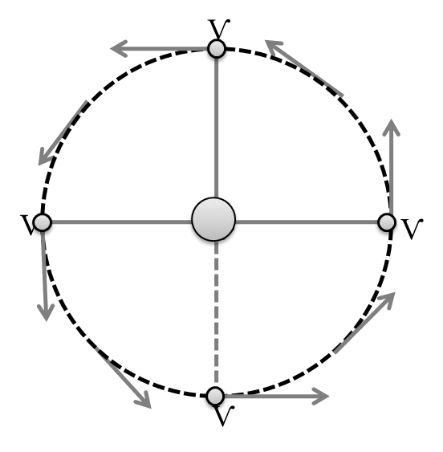
For top point
![]()
![]()
![]()
For middle position
v2 = u2 - 2gh
![]()
![]()
![]()
Tmin ≥ 3 mg
VERTICAL CIRCULAR MOTION
For Lowest point
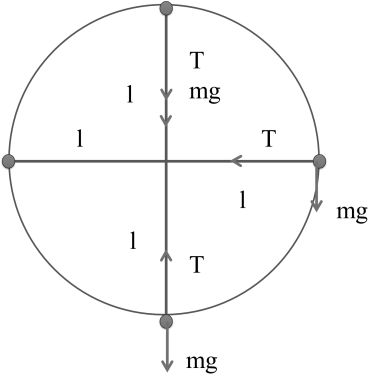
![]()
& Lowest to top
v2 = u2 – 2gh
![]()
![]()
![]()
![]()
Tmin ≥ 6 mg
STRING MASS SYSTEM
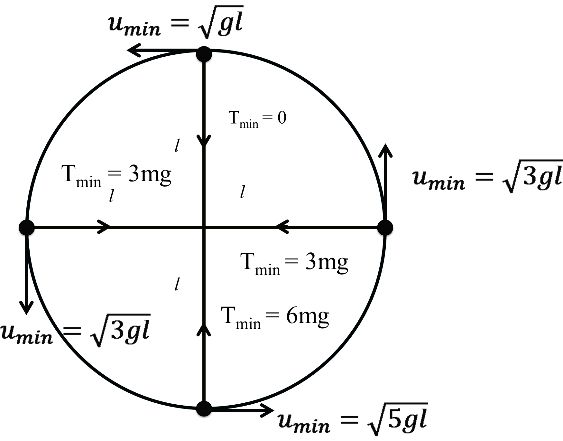
RIM & MASS SYSTEM
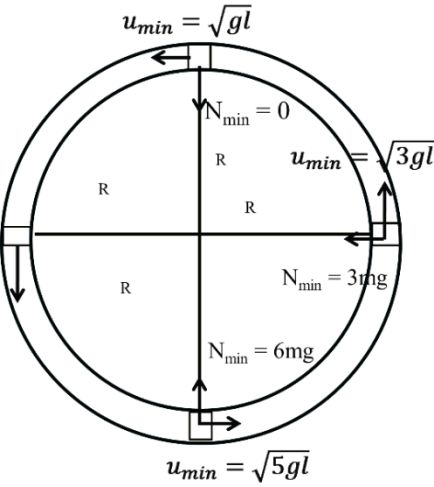
RIGID ROD AND MASS SYSTEM
To Complete the Circle if minimum velocity at top point = 0
![]()
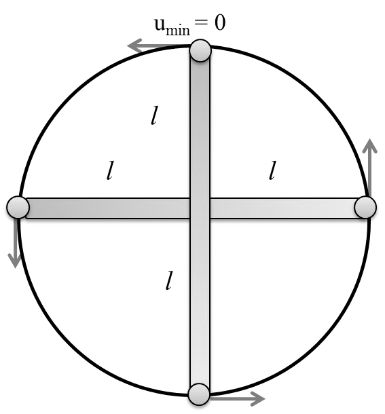
Then Top to bottom
v2 = u2 - 2gh
(o)2 = u2 – 2g x 2l
![]()
At mid point
![]()
Lowest to mid point
![]()
v2 = u2 – 2gh
![]()
INCOMPLETE CIRCLE
Case I velocity given at lowest position
![]()
Case II velocity given at lowest point
![]()
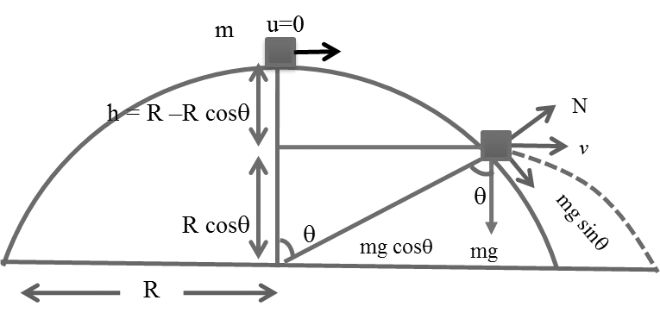
Example: As shown if figure a small mass m is put on the top of smooth hemisphere now this mass slightly hit to disturb it. At what angle it will leave the hemisphere.
![]()
Leaving the Circle so N = 0
![]()
![]()
Now from top to point where leave the Circle
v2 = u2 + 2gh
v2 = (0)2 + 2gR(1 - cosq)
gR cosq = 2gR (1 - cosq)
Cosq = 2 - 2 cosq
3 cosq = 2
![]()
![]()
RADIUS OF CURVATURE
Case I At top of projectile motion
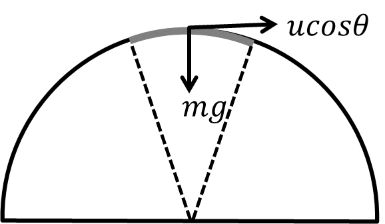
if we assume war the top point of projectile is a small Circular part then
![]()
![]()
Case II At any point before the top of projectile
At a point where velocity makes angle q/2 with horizontal
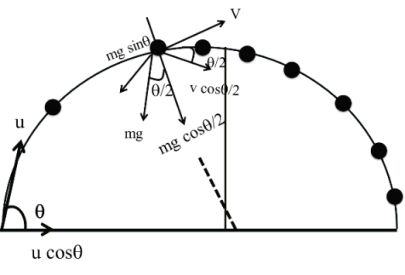
V cosq/2 = u cosq
![]()
![]()
![]()
![]()
Condition of toppling of a vehicle on circular tracks
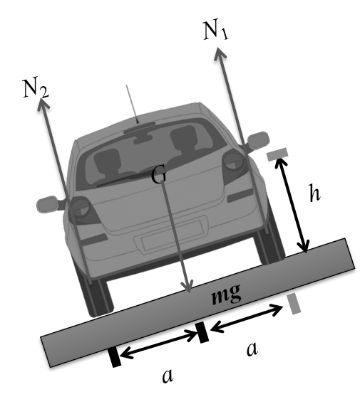
While moving in a circular track normal reaction on the outer wheels
(N1) is more than the normal reaction on inner wheels (N2).
Or N1 > N2
This can be proved as below.
Distance between two wheels = 2a
Height of centre of gravity of car from road = h
For translational equilibrium of car
N1 + N2 = mg … (i)
![]()
and for rotational equilibrium of car, net torque about centre of gravity should be zero.
Or N1 (a) = N2 (a) + f (h) … (iii)
From Eq. (iii), we can see that
![]()
Or N2 < N1
From Eq. (iv), we see that N2 decreases as v is increased.
In critical case, N2 = 0
and N1 = mg [From Eq. (i)]
N1 (a) = f (h) [From Eq. (iii)]
![]()
![]()
Therefore, for a safe turn without toppling![]()
From the above discussion, we can conclude while taking a turn on a level road there are two critical speeds, one is the maximum speed for sliding ![]() and another is maximum speed for toppling .
and another is maximum speed for toppling .![]() One should keep ones car’s speed less than both for neither to slide nor to overturn.
One should keep ones car’s speed less than both for neither to slide nor to overturn.
Case I
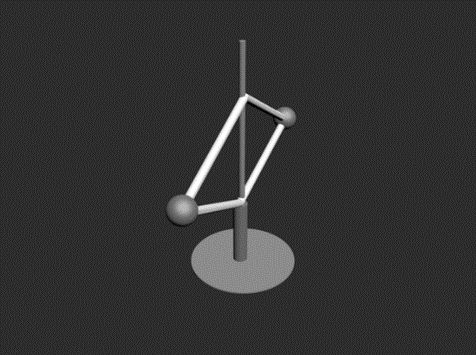
The length of each light rod is l. The mass of each small ball B and D is m. Balls are connected with a light smooth sleeve at point A as shown in the figure below. The frame is rotating with constant angular velocity w. A force F0 is
Question. If tension in AB wire is T1 and that in wire BC is T2. Then the value of (T2 – T1) is
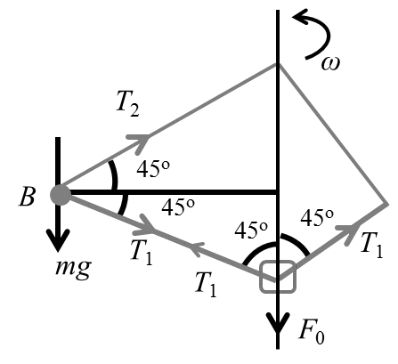
(a) mg ![]()
(c) 2 mg dmg2![]()
Solution: At the ball B,
T2 sin 45° = mg + T1 sin 45° (in vertical direction)
T2-T1=mgsin45°=2 mg …(i)![]()
Question. The required force F0 on the sleeve is
![]()
![]()
(c) 2 mg ![]()
Solution: T1 cos 45° + T2 cos 45° = mrw2 (in horizontal direction)
![]()
or T1 + T2 = mlw2 …(ii)
From Eqs. (i) and (ii), we get
![]()
For bead, 2T1 cos 45° = F0
![]() Answer (a)
Answer (a)
Case II
A spherical ball of mass m is kept at the highest point in the space between two fixed, concentric spheres A and B (sec fig.) The smaller sphere A has a radius R and the space between the two spheres has a width d. The ball has a diameter very slightly less than d. All surfaces are frictionless. The ball is given a gentle push (towards the right in the figure). The angle made by the radius vector of the ball with the upward vertical is denoted byq. (2002 JEE Advance)
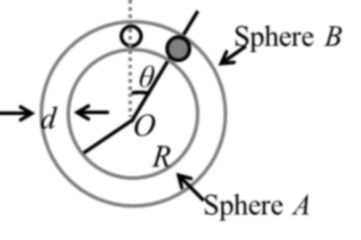
(a) Express the total normal reaction force exerted by the spheres on the ball as a function of angleq.
(b) Let NA and NB denote the magnitudes of the normal reaction forces on the ball exerted by the spheres A and B, respectively. Sketch the variations of NA and NB as function of cos q in the range 0 £ q £ p by drawing two separate graphs in your answer book, taking cos q on the horizontal axis.
Solution:![]()
Velocity of ball at angle q is
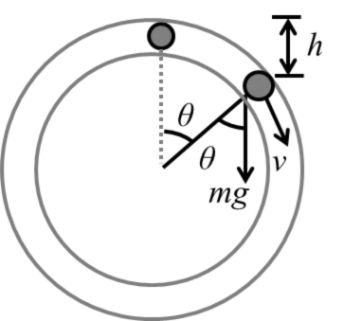
![]()
Let N be the normal reaction (away from centre) at angle q.
![]()
Substituting value of v2 from Eq. (i), we get
mg cos q - N = 2 mg (1 – cos q)’
N = mg (3 cos q -2)
(b) The ball will lose contact with the linner space when N = 0
![]()
After this it makes contact with cover sphere and normal reaction starts acting towards the centre.
![]()
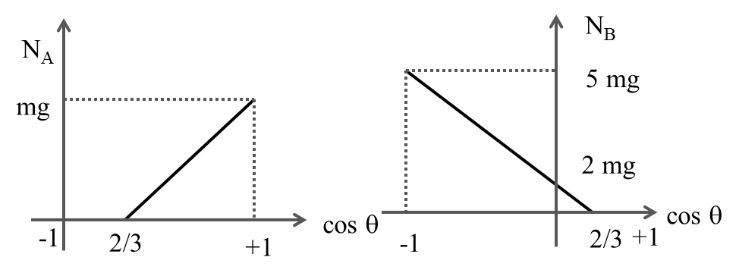
NB = 0
and NA = mg (3 cos q - 2)
![]()
NA = 0 and NB = mg (2 – 3 cosq)
The corresponding graphs are as follows.
Case III
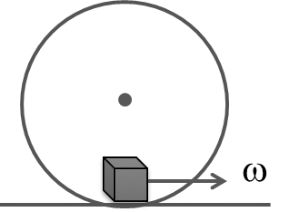
A small smooth block of mass m is projected with speed ![]() from bottom of a fixed sphere of radius, R so that the block moves in a vertical circular path.
from bottom of a fixed sphere of radius, R so that the block moves in a vertical circular path.
Question. The speed of the block as function of q, the angle of deflection from the lowest vertical.
![]()
![]()
Solution: From free body diagram of the block, - mg sin q = mat
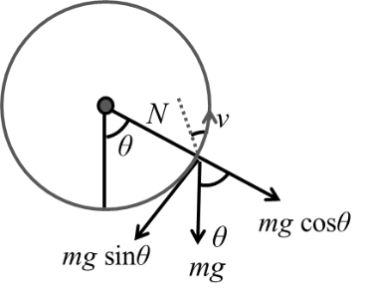
![]()
![]()
![]()
![]()
or v2 = 2gR – 2gR (1 – cos q)/
![]() Answer (b)
Answer (b)
Question. Normal reaction at the moment when vertical component of the block’s velocity is maximum.
(a) mg ![]()
![]() (d) 2 mg
(d) 2 mg
Solution: From the figure, vertical component of velocity is
![]()
![]()
![]()
![]()
![]()
![]() Answer (c)
Answer (c)
Question. The angle q between the thread and the lowest vertically at the moment when the total acceleration vector of the block is directed horizontally.
![]()
![]()
![]()
![]()
Solution: From the figure, the centripetal acceleration is ![]()
and a tangential acceleration is at = a cos q
or g sin q = a cos q
a = g tan q
![]() or v2 = gR tan q sin q
or v2 = gR tan q sin q
or 2gR cos q = gR tan q sin q
![]() Answer (c)
Answer (c)
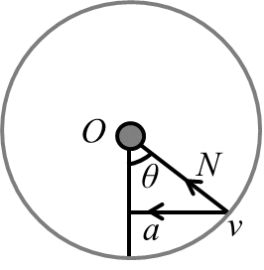

 Kaysons Publication
Kaysons Publication
